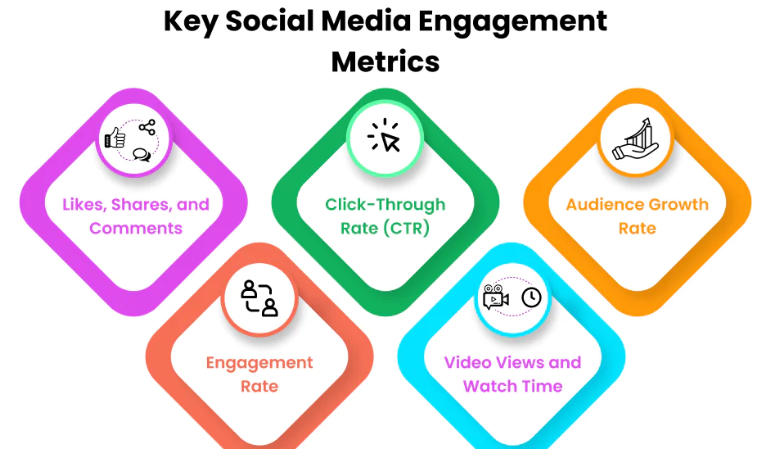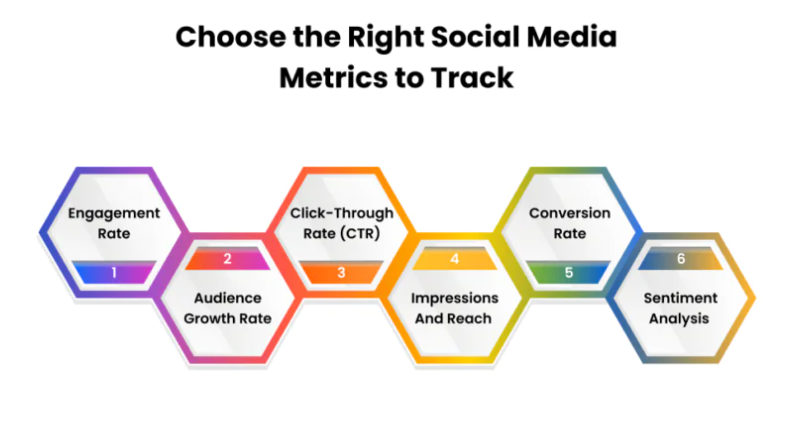Social media involves the ultimate task of balancing creativity and analysis. However, if creativity is the icing on the cake then, social media metrics are the essential building blocks that make the final dish come alive.
There is no one-size-fits-all rile to measuring social media metrics. Instead, it requires a balanced mix of multiple metrics to show how social media affects the whole business. The key metrics that will be critical to your strategy and reporting will depend on your brand, business goals and strategies.
Social media metrics are essential for measuring your strategy’s effectiveness. It goes beyond surface-level numbers to show how your content resonates with your audience. The following article will highlight the most important social media metrics to track in 2025. It will also detail how to use them to build your online presence.
What Are Social Media Metrics?
Social media metrics refer to the data points essential for tracking the performance of your social channels, strategy, content and the impact that they have on your business goals. The help to measure the effectiveness of your social media strategy and understand how to make improvements.
Other marketers simply define social media metrics as the pulse of your brand’s online presence. They are numbers and percentages that show how well your social media activities are doing. They can help you to track social media engagement on your posts, brand mentions and other important elements.
The metrics for social media explore everything that could impact the online reputation of your brand. They answer questions such as:
- How do users engage with your content?
- How well does your content achieve its intended outcome?
- How quick and effective is your social media customer support?
- Are you achieving your social media goals, whether follow growth, engagement or leads?
For example, measuring social media engagement can offer you a comprehensive understanding of how your content resonates with your audience. It could also provide invaluable insights to help you identify opportunities to better resonate with your audience.
Sometimes, the analysis of social media metrics can be instrumental in discovering larger business opportunities. For example, it can help you to identify a new market segment. The metrics are like scorecards for your online posts and interactions, indicating how many people saw, likes, commented or shared your content. They can also reveal the amount of effort and money that you are investing and, how much you are receiving in return.
The Importance of Measuring Social Media Metrics
The implications of measuring social media metrics go beyond social channels. The data is business intelligence that helps to inform the health, competitiveness and ideal performance benchmarks of your brand.
According to The 2023 State of Social Media report, more than half of business leaders say that social media data and insights currently inform their companies’ business strategies.
Measuring the metrics for your social media channels also helps you to clearly illustrate the value of social and your ROI. That is essential for securing investment in your social strategy. The 2025 Sprout Social Index shows 65% of marketing leaders ager positive that demonstrating how social media campaigns are tied to business goals is crucial for getting buy-in.
The Essential Social Media Metrics to Track
There are several types of social media metrics that you need to keep an eye on. This article has put them into categories to help you keep things organized. Here are the most essential metrics for social media and how to track them.
Social Media Engagement Metrics
Social media engagement metrics show how often people interact with your content. Engagement proves that your audience is interested enough in the content that you post to take action on them. Besides, engagement sends a powerful signal to the social media algorithms, which could help with expanding your reach.

- Engagement rate
Engagement rate measures the number of engagement on your posts including likes, comments and shares, as a percentage of your audience.
The definition of audience may vary but, you should calculate engagement rate based on the number of followers on your profile. However, you should remember that not all your followers will see every post. Besides, you may also get engagement from people who are not your followers.
There are various ways to calculate engagement. One of the most common options is adding your total likes, comments, shares and saves then, dividing by the number of followers. Then, multiplying the figure by 100 to get a percentage.
- Likes and Reactions
Likes refer to the number of people who have physically ‘’liked’’ or ‘’reacted to’’ one of your posts. Although some marketers view this as a vanity metric, it still holds a lot of weight in your overall engagement rate.
With more platforms such as Facebook and LinkedIn introducing reactions, the likes and reactions metrics will also help you in gauging actual sentiment about every post. Do people support your social media content? Are they enjoying it?
You could also look at the number in whole to get an idea of the number of people who thought your post resonated well enough with them to take action.
If you are tracking the likes on your posts, you may simply want to keep a counter going to watch these engagement metrics grow. For instance, look at the number of likes your content gets weekly or monthly to ensure it is growing.
- Comments
The number of comments that you get on each post is also a great measure of engagement. A like or reaction is an easy and simple action for most people but, leaving a comment means your audience actually have something to say.
The comment section is often filled with feedback and inspiration. However, it is also a great social media metric to track since it shows the effectiveness of your posts and increasing love from your followers.
You should keep an eye on this metric to ensure that the comment section is growing over time. Remember your comment count should also go up as your audience grows and becomes more invested in your brand and business.
- Shares
This is the key indicator of how much your audience likes your content. It shows your audience’s interest in sharing the content on their profiles so that their friends and followers can see it.
A 2024 Consumer Report established why people share content on social media. One of the reasons is because people agreed with the content. Some also say they shared content because they found it informative. Others also said it was because the content was inspirational.
Regardless of the reasons behind it, sharing content is an emotional response and a testament to how well your content was received.
Keep track of the number of shares your content gets over a given period to ensure that it is growing. If you notice a reduction in shares, go back to see the kind of content that attracts the most shares and create more of that type of content.
Reach Metrics
Reach refers to the number of people who see your content. It is a great idea to keep an eye on your average reach as well as the reach of individual posts, stories or videos. Remember you can also measure the overall reach of your account.
- Reach
An important subset of this metric is to look at the percentage of your reach that comprises followers and non-followers. If so many of non-followers are seeing your content, it means the content is being shared or doing well in the algorithms, or both.
- Impressions
Impressions refer to the number of times people saw your content. You can track impressions by post and the overall number of impressions on your social media profile. Impressions can be higher than reach because the same user might look at your content more than once.
A higher level of impressions than reach means people are looking at a post several times. Do some research to find out if you can understand why those social media metrics are the way they are.
You should remember that not all social media platforms have both reach and impressions. For instance, the total video views on TikTok is the equivalent of impressions. Besides, YouTube and Twitter only offer impressions; not reach.
- Social Share of Voice (SSoV)
Social share of voice tracks the number of people talking about your brand on social media compared to your competitors. Find out the amount of social conversation in your industry that revolves around you and your brand. Mentions can either be direct or indirect.
SSoV is essentially like a competitive analysis, seeking to establish your brand’s visibility and relevance in the market. If you are not sure about where to start, social media management tools can be of great help with that.
- Video views
While video views may come off as a vanity metric, they count as impressions on platforms like TikTok. Thus, they are also important social media metrics to track. Video views are also good indicators of the amount of awareness that you are generating with your content. However, this metric can be more powerful when combined with other metrics such as engagement, view duration and shares.
Wondering how to boost your brand’s reach and presence on social media? Engage Superior Social Boost for the ultimate solutions. We help brands to enhance their visibility and reach on social media, with customized packages for TikTok, Facebook, Instagram, X, YouTube and Google Business.
Audience Growth Metrics
Follower growth tells a more complete story about the health of your channel, the awareness that you are building and whether you are outshining your competitors or falling behind. The following are crucial audience growth metrics to track.
- Follower growth
Follower growth measures the net followers you gained in a given time frame. Simply subtract the number of followers you had at the start of a given period from the amount of followers you have at present.
Although follower growth alone will not give you much information, knowing the number of followers that you have acquired is a powerful way to prove the ROI of various types of content, campaigns and social media experiments.
- Follower growth rate
Follower growth rate is a percentage showing how quickly your audience is actually growing or slowing, within a given duration. To calculate the follower growth rate, simply multiply the followers you gained in a specific time by the initial number of followers you had before that gain then, divide the figure by 100 to get a percentage.
- Audience size
While some marketers regard audience size as one of the vanity social media metrics, it is an important indicator to track. Keeping track of changes to your follower count monthly, quarterly or yearly is a crucial data point. It helps with determining the performance and health of your social media platform.

Social Media Metrics: The Bottom Line
While there are several other metrics that you should also keep track of, the ones discussed above are the most crucial. Overall, monitoring your social media metrics is fundamental to understanding your overall performance and improving your social media strategy. That means you will be able to grow your online presence faster and increase your social media ROI over time.

